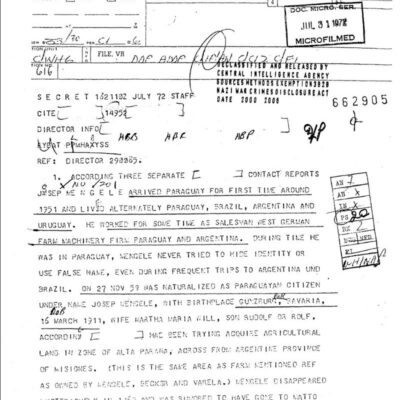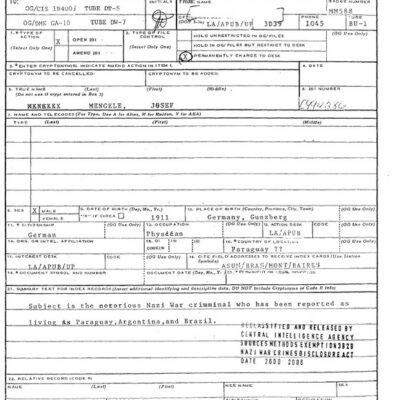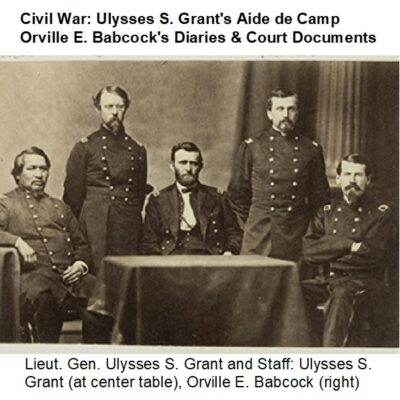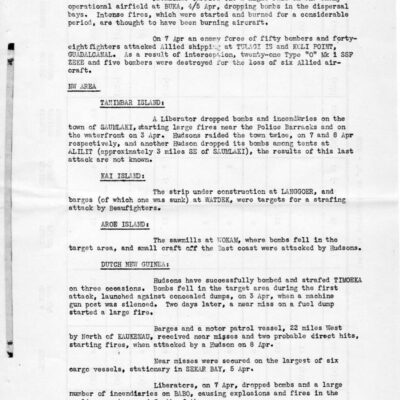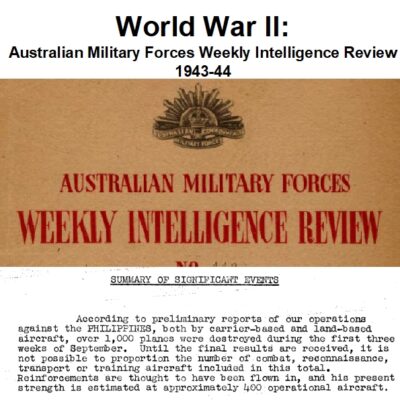

World War II: German Control and Crimes in Europe OSS Reports (1943-1945)
$19.50
Description
Nazi Germany: A Chronological Overview
Timeline of Events (1919-1945) based on the OSS Reports:
- 1919-1923: Early Nazi Terror and Violence (as described in R&A No. 3114.1)
- 1919: Post WWI, political violence and assassinations occur in Berlin, and Munich, including the participation of groups such as the Rossbach Corps.
- 1919-1922: Political unrest and violence continue in Munich.
- Early 1920s: The Battle of Coburg, Kapp Putsch (attempted coup), and activities of the Consul Organization take place, along with the assassination of Walter Rathenau.
- Early 1920s: “Feme Murders” and the Kuestrin Putsch occur.
- 1923: The Hitler Putsch, an attempt by the Nazi party to seize power, takes place.
- 1930-1934: Consolidation of Nazi Power and Increased Terror (as described in R&A No. 3114.1)
- Early 1930s: Rise of Nazi terrorists and increasing political violence.
- Early 1930s: Nazi violence against political opposition; increasing role of Nazi leadership and “heroes of the nation” in political violence.
- 1934: The “Night of the Long Knives” (also known as the Röhm Putsch), a purge of the SA leadership and other political opponents.
- June 30, 1934: The Rohm Putsch/Night of the Long Knives. (Referenced in R&A No 3113.1 & 62.04)
- June 30, 1934: Willi Schmidt, music critic, killed in mistaken identity during Rohm Putsch; SS intended target was likely SA leader Willi Schmidt. (Referenced in R&A No 62.04)
- 1933-1945: Nazi Legal and Political Changes (various reports)
- Post 1933: Systematic dismantling of the Weimar Republic’s legal framework, Nazi changes to criminal procedure, real property law, and inheritance law.
- Post 1933: Suppression of labor organizations and political parties.
- Post 1933: Muzzling of the press.
- Post 1933: Implementation of “enabling legislation” consolidating Nazi power.
- Post 1933: Nazi “racial and health policy,” including laws for marriage loans, tax reduction for families, and sterilization programs.
- 1933-1945: Persecution of Jews (R&A No. 3114.3 & R&A No. 2027)
- Pre-WWII: Discrimination and expropriation of Jewish property in Hungary.
- Post 1939: Implementation of systematic anti-Jewish measures, including the establishment of ghettos and concentration camps.
- 1940s: Mass deportations of Jews from Hungary and other Nazi-occupied territories.
- 1939-1945: Economic and Territorial Expansion (various reports)
- Post 1939: Illegal annexation of territory by Nazi Germany.
- Post 1939: Economic spoliation of occupied Europe.
- Post 1939: Establishment of German Military Governments in occupied territories, with military and police tribunals.
- Post 1939: Control of economies in occupied countries, exploitation of labor and resources, and policies of forced labor.
- 1939-1945: Persecution of Other Groups (various reports)
- Post 1939: Persecution of Christian churches in Germany and occupied Europe.
- Post 1939: Crimes against foreign laborers.
- Post 1945: Allied Investigations and Trials (various reports)
- 1943-1945: OSS research and analysis of German crimes, preparing material for war crimes investigations and trials.
- Post-War: Focus on Nazi criminal responsibility, leadership principle, and specific crimes, including crimes by Hermann Goering and Nazi organizations.
- Post-War: Soviet attitudes toward war crimes, criminal responsibility, and legal jurisdiction, as well as Soviet procedure for war criminals.
- Post-War: French approach to dealing with collaborationists, the purge laws, and their operation.
Cast of Characters and Brief Bios:
- William J. Donovan: Head of the Office of the Coordinator of Information (COI). Ordered by President Roosevelt to create a plan for a US intelligence service. Founder of the Office of Strategic Services (OSS).
- Franklin D. Roosevelt: President of the United States. Ordered the creation of the OSS.
- Adolf Hitler: Leader of the Nazi Party and Chancellor of Germany. Central figure in the planning and execution of Nazi crimes. (Mentioned in many reports as a prime mover of events)
- Hermann Goering: A high-ranking Nazi official, Commander-in-Chief of the Luftwaffe, and head of the Four Year Plan. Deeply involved in Nazi economic policy, the persecution of the Jews and other crimes. Subject of R&A No. 3152.
- Ernst Röhm: Leader of the SA (Sturmabteilung). Purged and executed during the Night of the Long Knives.
- Walter Rathenau: German politician and industrialist who was assassinated by right-wing extremists.
- Willi Schmidt (music critic): Mistakenly murdered during the Night of the Long Knives, his death is believed to be an unintended one.
- Willi Schmidt (SA Leader): The likely intended target of the SS during the Night of the Long Knives, in the incident where a music critic with the same name was killed.
- Dr. Gisevius: Author of The Frenzy of the Masses and The Thirtieth of June, providing additional information on the Rohm Purge.
Key Organizations:
- OSS (Office of Strategic Services): United States intelligence agency during WWII, forerunner of the CIA. Created many of the reports that are the basis for this timeline.
- SA (Sturmabteilung): Nazi paramilitary organization. Targeted for purge during the Night of the Long Knives.
- SS (Schutzstaffel): Nazi paramilitary organization. Deeply involved in the execution of Nazi crimes.
- Wehrmacht: The German armed forces.
- Gestapo: The Nazi Secret Police.
- NSDAP (Nazi Party): The political party that controlled Germany under Hitler.
- Reich Government: The government of Nazi Germany, key to passing laws and policies in service of the regime’s objectives.
- Soviet Extraordinary State Commission: A Soviet organization involved in the identification and accusation of war criminals.
Over two thousand pages of OSS reports detail Nazi war crimes in Europe.
The OSS, the CIA’s predecessor, was a World War II US intelligence agency. President Roosevelt tasked William Donovan with creating it, modeling it after British intelligence agencies. The OSS’s mission was to coordinate espionage in enemy territory for the US military. Its main operations were in Axis-occupied territories and Asia. The OSS was disbanded in 1945, its core functions later absorbed by the CIA in 1947, which now holds its archives.
The OSS’s Research and Analysis Branch gathered, assessed, and analyzed diverse intelligence—political, social, economic, geographic, and military—for operational needs and government requests, producing reports, maps, and other visual aids. The Office of Strategic Services’ Research and Analysis Branch produced numerous reports primarily for Allied war crimes investigators and prosecutors. These reports extensively examined Germany’s history, culture, socio-economics, and wartime actions. The reports covered diverse subjects, including Germany’s war preparations, legal systems, and property laws, as well as Nazi organizations, concentration camps, and the Holocaust.
Examples include a report detailing German concentration camps (R&A No. 1844), another on the persecution of Hungarian Jews (R&A No. 2027), a third describing German military tribunals in occupied Europe (R&A No. 2500.18), and a final report on Soviet plans to prosecute war criminals (R&A No. 1988.1). This document examines the Soviet Union’s stance on war crimes, criminal liability, and legal jurisdiction, along with their procedures for handling war criminals. A list of those accused by the Soviet Extraordinary State Commission is included.
This project aims to determine the legal responsibility of Nazi organizations like the Party, the Reich Government, and the Wehrmacht for specific crimes. Focusing on these organizations, rather than individuals, should speed up prosecutions and demonstrate that Nazi war crimes weren’t isolated incidents but part of a larger, planned effort relying on these groups.
This report expands on the 1934 Nazi purge, analyzing its nature, events, official justifications, and the responsibility for deaths during the purge, assigning specific blame where possible.
This document focuses on Hermann Göring’s role as a war criminal. This study aims to categorize the main crimes Hermann Göring could be charged with, further breaking them down into subcategories. For instance, “domestic crimes” are divided into crimes committed through the Gestapo, crimes related to the June 1934 purge, and anti-Jewish persecution. For each crime, the analysis details the specific acts, available evidence, Göring’s responsibility (including his positions, orders, and statements), applicable laws, and any weaknesses in the evidence.
This document adds to existing reports on Göring’s war crimes and Nazi organizations’ roles in war crimes, particularly focusing on the Röhm Purge. Some information appears to come from Dr. Gisevius’s writings. It also describes the accidental killing of a music critic, possibly mistaken for an SA leader.
This document is an addendum to a report on the Nazi regime’s systematic persecution of Christian churches. This research uses concrete examples to detail the Nazi regime’s persecution of Christian churches in Germany and occupied territories.
A 1945 report (R&A No. 3114.1) examines Nazi attitudes towards their political terrorism, ranging from denial and apprehension to open acknowledgment and glorification. The report details the fates of both victims and perpetrators of Nazi crimes against political opponents, covering events from 1919 to 1934.
Another 1945 report (R&A No. 3081) contrasts the German criminal justice system before and after the Nazis seized power.
A third report (R&A No. 3108) from July 15th, 1945, analyzes France’s approach to collaborators during and after the German occupation, including the legal framework, implementation, effectiveness, flaws, and resulting political issues.
Finally, a fourth report (R&A No. 3110) discusses the “leadership principle” and its implications for criminal responsibility under the Nazi regime. This study examines how the Nazi leadership principle contributed to the war crimes committed by Nazi leaders across various sectors, including the state, party, and economy. It analyzes Nazi leaders’ statements and writings on this principle to determine the extent of their criminal liability.
This document defines “spoliation of property” broadly, encompassing all illegal actions harming the economic well-being of occupied territories. This goes beyond individual property rights (the Hague Conventions’ main focus) to include the overall economic exploitation of nations through illegal means or to an illegal degree.
This report’s introduction states that Nazi Germany’s early war successes led to the exploitation of millions of foreign workers. The crimes against these workers, and others later conscripted, weren’t isolated events but part of a broader criminal strategy aimed at exploiting, subjugating, and often exterminating foreign populations.
This document details domestic crimes committed by the Nazis. This document is divided into two sections. The first section examines whether Nazis can be held criminally liable under German law for their actions. The second section details the Nazi regime’s offenses, including the suppression of unions and political parties, censorship, and the unlawful passage of enabling acts.
The introduction argues that the main challenge in the first section is refuting the Nazi defense that their actions were legal under the Third Reich. While proving the Nazi regime’s illegitimacy as a successor to the Weimar Republic is possible, the Nazis might argue their power legitimized their rule. The report counters this by asserting that a government’s legitimacy hinges on its representativeness and popular support.
A 1945 report (R&A No. 3114.3 Part 1) details Nazi plans for global dominance, portraying the annihilation of Jews as a key element of a broader conspiracy. This conspiracy, involving the German government, Nazi Party, and leaders from military, industrial, and financial sectors, aimed at world conquest through war; the genocide of Jews served both as a goal in itself and as a means to that end. The widespread persecution of European Jews under Nazi rule wasn’t a series of unrelated acts of violence, but a single, unified crime: a planned genocide.
Every German action against Jews, from minor discrimination to mass extermination, whether officially sanctioned or carried out by individuals or groups, was part of this overarching conspiracy. This internal report for war crimes prosecutors explains how seemingly benign Nazi policies were part of a larger genocidal plan. While initiatives like marriage loans and family subsidies appeared innocuous, they were actually racially discriminatory, benefiting only those deemed “racially preferred” and excluding others. These policies, along with marriage and procreation restrictions, aimed to eliminate undesirable populations. Furthermore, ostensibly medical sterilization and castration laws were manipulated to justify the murder of political and racial opponents.
A separate document, R&A No. 2500.15 from August 28, 1945, analyzes the German economic strategies in occupied Europe during the war. It investigates both the direct and indirect methods of economic control and exploitation, aiming to uncover the underlying political goals of these actions. This document (R&A No. 3113.3, August 28, 1945) aims to identify how Nazi laws led to war crimes, not to determine individual guilt.
It outlines key Nazi legislative bodies like the Reich Cabinet and their roles, and lists documents detailing the structure and function of other government agencies. Related reports cover various topics, including German military government in several European countries, Prussian militarism’s influence on Nazi imperialism, illegal anti-democratic activity in post-WWI Germany, Nazi alterations to property and family law, and the Nazi Party’s involvement in war crimes. Document 3113.7, dated September 10, 1945, details the Nazi Party’s role in war crimes, focusing on its principal organizations. This is part five of the report.
